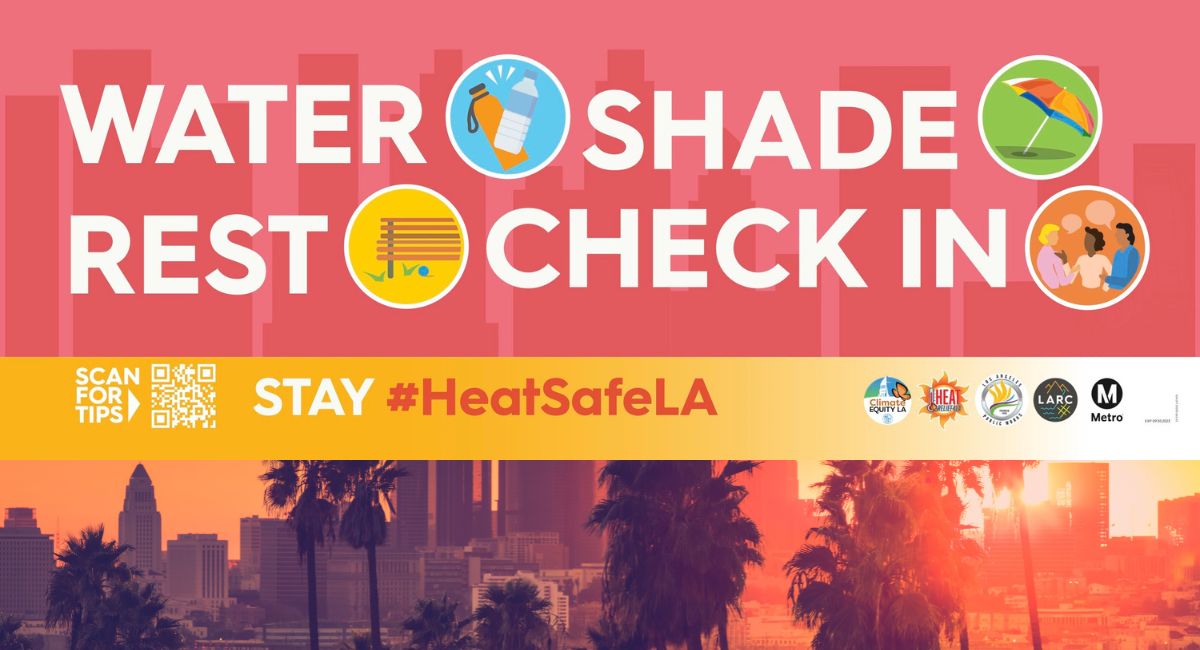As temperatures soar into the triple digits during this summer’s first heat wave in Los Angeles, Sandra Villalobos has been going door-to-door sharing information with neighbors on how to stay cool.
Her bilingual team of promotoras — community health workers with the nonprofit Visión y Compromiso — is fanning out around her Boyle Heights neighborhood with materials in Spanish and English.
Villalobos said, “We could tell when we open the door how hot and humid it was inside.”
The promotoras urge residents to get air conditioning or at least fans for what is predicted to be a long hot summer. They distribute towels to moisten and drape around overheated necks and umbrellas for shade when people venture outside.
The promotoras are part of a citywide campaign in English, Spanish, Chinese, Korean, Vietnamese, and 10 other languages, working with 27 community-based organizations to spread the word about the dangers of extreme heat and what residents can do to protect their families and pets.
“It’s critically important that all communities, but in particular vulnerable communities, receive this kind of information in advance of a heatwave,” said Marta Segura, the city’s chief heat officer and director of its climate emergency office. “Heatwaves are lasting longer. They are more frequent. So they are impacting communities, now more than ever.”
Los Angeles is well-known for sunshine nearly year-round. But that sunshine and rising temperatures due to climate change are now a threat to public health. Extreme heat can be extremely dangerous, especially for vulnerable populations such as the elderly and children and in communities with little shade.
The potential for harm is compounded when communities experience other vulnerabilities such as poor mobility, aging housing infrastructure, lack of green space, or linguistic isolation. According to a statewide survey on climate-related social vulnerability, while 27% of the state’s population lives in Los Angeles County, it is home to 40% of the state’s highly vulnerable population, about 5 million people (LA County Vulnerability Assessment, 2021).
The city’s extreme heat preparedness campaign, Heat Relief 4 LA, will run through the summer and into the fall, when some of the hottest temperatures can occur in the city. But the first heat waves are of most concern as people’s bodies have not yet acclimated to major temperature shifts, and Segura worries that this year’s summer is projected to be one of the hottest on record.
The campaign is prioritizing the most vulnerable communities in Los Angeles and deploying multilingual campaigns in areas of the city where many families speak languages other than English at home. And the 27 community-based organizations are each using unique strategies to reach their respective communities.
Black Women for Wellness, an organization that focuses on reproductive health and environmental justice, is conducting workshops and distributing newsletters in South L.A This summer, Black Women for Wellness is distributing a “Stay Cool Guide” for pregnant mothers.
“While heat relief isn’t our main campaign, it’s a crucial issue for our community,” said communications managers Myeisha Essex. “Extreme heat affects Black women and other marginalized groups due to systemic inequities in housing, access to green spaces, and healthcare.”
The city’s climate emergency office is helping Black Women for Wellness address those closely related issues and the organization will also be involved in designing a “heat action plan” for the city that includes a reproductive justice framework.
“Our involvement will ensure that the plan addresses the unique needs of Black women, promoting equity and resilience in the face of climate change,” Essex said.
In the city’s downtown Chinatown neighborhood, the Southeast Asian Community Alliance, is sending outreach teams several times a week to check on residents who live in buildings that are over 100 years old without elevators, comprised of single-room occupancy units without air conditioning. Most are low-income, elderly, and have limited mobility.
The alliance is distributing Chinese language materials from the climate emergency campaign, while also applying its understanding of the special nature of the neighborhood and the vulnerabilities of its residents.
Sissy Trinh, executive director of the alliance, said many residents buy their rice by the cup because they cannot carry or store large amounts. So, water, which weighs much more, also has to be distributed in more frequent, smaller quantities, too.
The neighborhood’s precarious housing conditions and a dense urban environment with little green space and shade all underscore the importance of neighborhood cooling centers, such as air-conditioned libraries and recreation centers, as essential infrastructure during extreme heat events, she said.
“We have tenants that are one rent increase away from becoming homeless,” said Trinh. “Seniors are skipping meals in order to have enough money for rent at the end of the month. AC is a luxury.”
This story was produced by Ethnic Media Services in collaboration with the Laboratory for Environmental Narrative Strategies (LENS) at UCLA as part of the Greening American Cities initiative supported by the Bezos Earth Fund.




